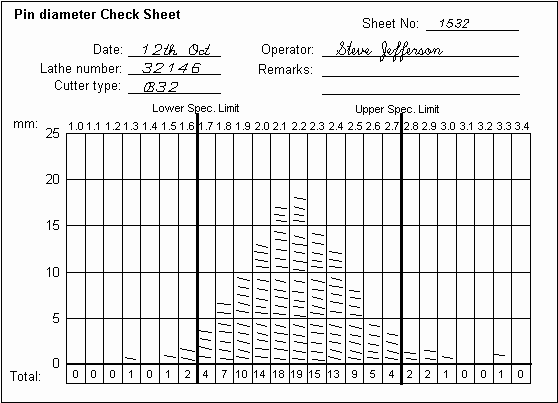Check Sheet: How to do it
The Quality Toolbook >
Check Sheet > How to do it
When to use it | How to understand it |
Example | How to do it | Practical
variations
<-- Previous |
Next -->
How to do it
- Identify the end objectives of the measurement, such as what questions are to be answered and what decisions are to be made. Consequently, identify what data needs to be collected, and in what format. Common uses for Check Sheets include:
- Measuring the distribution of a set of measurements.
- Counting and classifying defects into various types.
- Identifying the physical location of defects.
- Verifying that actions have been completed.
- Identify the data that needs to be collected about the process. This should include all variables which could be problem causes or could contribute to variation in results, such as date, time, operator, batch number, machine reference, etc.
- Identify the period and circumstances of data collection and consequently estimate the maximum number of measurements per Check Sheet.
If samples are being taken (as opposed to measuring everything), make sure that these are planned carefully, for example by taking sufficient measurements at appropriate points in the process.
- Design the Check Sheet, aiming to ease the collection, transcription and interpretation processes. A typical form includes:
- An area for the data about the process.
- An area to collect the main data, organized so that it may be visually interpreted. This should be large enough to contain the maximum expected number of data elements (step 3).
- Columns or rows to total the data, ready for transcription (typically into a computer, for later reference or further analysis).
- Other information about the situation where the data was collected that may help decision making, such as operator, date, machine, weather, etc.
Common designs for Check Sheets are discussed under Practical variations, below.
- Ensure the Check Sheet works as intended by testing it, preferably in a live situation.
- Ensure users are able to use the Check Sheets properly. This may include training, adjusting work instructions, etc. In any case, the data recording should not be too intrusive.

Fig. 1. Check Sheet to show pins within specification
- Collect the data, ensuring all required data is entered onto the form and can be clearly read. Ensure that representative samples are being taken for the conclusions that will be drawn from the results (for example, assumptions about everyone cannot be made if only one person is using it).
- Interpret and use the results as planned.
<-- Previous |
Next -->
|